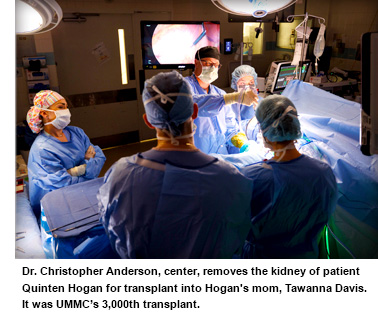Giving patients our best
Good morning!
As we’ve recently discussed in this column, UMMC’s 2025 strategic plan is ambitious and multi-faceted to reflect our three-part mission of education, research and health care. Today, let’s talk about how we aspire to take care of patients, many who receive the most specialized treatments available in Mississippi, and how we give them value in making UMMC their provider of choice. While they’re with us, we want to give them the best experience that we can.
 When it comes to our clinical enterprise, the safety and well-being of our patients are our top priorities and we are always thinking about improving patient experience, access to UMMC-connected care and availability of services Mississippians need.
When it comes to our clinical enterprise, the safety and well-being of our patients are our top priorities and we are always thinking about improving patient experience, access to UMMC-connected care and availability of services Mississippians need.
Our performance and quality initiatives drive outcomes for outpatients in our clinics statewide, and for inpatients in our hospitals in Jackson, Grenada and Lexington. Our future growth and development hinges in part on how we deliver health care and grow our services. In the second year of our five-year strategic plan, we are evaluating our work toward achieving our goals, and adjusting as needed.
We set new goals annually for our five main strategies:
- Maximizing value in quality of care
- Driving strategic clinical growth
- Expanding health care services statewide
- Positioning academic programs for the next generation of learners
- Strengthening research programs
Our goals focus in part on our strategies for maximizing value in our quality of care and accountability in how we achieve that. Believe me, we have many plans, including creation of an Office of Performance Improvement to guide us in meeting standards and expectations for our organization. Let’s break down how that looks – knowing this is just a glimpse of the work ahead.
What really matters to our patients? The big things, yes, but also things we might consider routine that they consider huge in the patient experience. For example, we want to prioritize, standardize and improve our inpatient transfer processes – such as transferring a patient from the Emergency Department to a floor, from surgery to a floor, or from one floor to another. It includes how patients are transferred from other hospitals to ours.
When patients come through our doors, do they feel respected from the nurses, the person who checks them in at a clinic, the ambassador who rolls them from an inpatient procedure to their room, the person who brings them a meal, the physician who explains their treatment or talks to them at bedside? What about the family member who is trying to get an appointment for a loved one, but is told there will be a considerable wait? Do we assure them we understand their need and want them seen as soon as a provider is available?
Our patients want a minimum wait to see a provider, and to have an efficient, patient-oriented approach to services – for example, getting blood drawn, scans performed, seeing a nutritionist and having appointments with multiple specialists, all in one trip to the Medical Center. That’s the face of multidisciplinary care. Its goal is to enable a patient to group related services in a single visit, allowing them fewer trips to campus or clinics. Considering the heat and head-spinning gas prices alone, multidisciplinary care is a smart efficiency and enables a better patient experience.
Inpatient care coordination is a mainstay of an academic medical center, and it’s something we are making part of our fabric. A patient doesn’t just see their physician at bedside. Gathered inside and outside their room will be a broader health care team that can include pharmacists, nurses, social workers, residents, nurse practitioners and additional specialists assigned to that patient’s care, all working together, all taking part in the discussion.
Our goal is for such multidisciplinary rounds to occur in clinical units more than 75 percent of the time. And along those lines, we’re committed to a priority patient discharge program. If you’re told at 9 a.m. you are being discharged that day, we want you on your way home by noon. Our immediate goal is that happens for qualifying patients at least 50 percent of the time.
As we improve patient access to our clinics, we want to build in accountability through dashboards that monitor agreed-upon metrics for access and satisfaction – and we will make action plans for what we will do to improve if those metrics fall below national benchmarks.
Our strategic plans also call for creation of a task force to identify the resources that are necessary for the Medical Center to continue growing its affiliations and relationships with other hospitals and clinics statewide. We want to grow our footprint to reach as many Mississippians as possible who will benefit from our care. These affiliations foster partnerships that allow us to provide services a hospital lacks, and to welcome the complex patients they send us who need a higher level of care. We’re creating a process to monitor the value that each affiliation contributes to the Medical Center.
We are fine-tuning our plans to better channel patients through all of the processes, and to give them the highest quality care and to maximize the value in the care we provide. It’s our mission to treat the sickest of the sick and to embrace a patient population that often copes with life-threatening, chronic diseases. We remain #UMMCStrong as we work through our goals and strategies on the road to creating A Healthier Mississippi.



